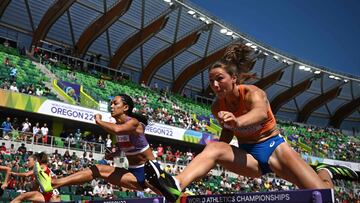How high are the hurdles in athletics and why do men run 110 meters and women 100?
Sprint hurdle events differ for men and women - in terms of the length of the race and the height of the hurdles. We explain why.

Hurdling, an obstacle race event in which athletes must jump over a series of barriers placed at determined intervals, has been a part of the Olympic programme since the first Games were held in Athens in 1896.
In that inaugural edition, there was just one hurdling event - the 110 meter race, in the men’s category only - and initially with just four finalists. Two of them, France’s Frantz Reichel and USA’s William Welles Hoyt, withdrew which meant that the first ever Olympic 110m hurdles final was a two-man race between the United States’ Thomas Curtis and Grantley Goulding representing Great Britain. It was a photo finish, both men recording an identical time of 17.6 seconds but the American was judged to have crossed the line five centimeters ahead of his rival and took gold.
The event evolved over the following decades, with changes to the qualifying heats format and an increase in the number of finalists - from six in 1912 to the standard eight, which competed for the first time at the Tokyo Games in 1960.
The first women’s sprint hurdle event at the Los Angeles Games
The women’s sprint hurdle event was introduced in 1932 at the Los Angeles Olympics track and field programme but the race was shorter than the men’s event. The inaugural women’s sprint hurdle event was over 80 meters rather than 110. It was won by American all-rounder Babe Didrikson, who knocked a second off the world record in the heats, then broke it again in the final, crossing the line on 11.7.
Didrikson’s record stood until Ondina Valla shaved 0.1 second off it in the semi-final heats in Berlin four years later. Australia’s Shirley Strickland was the first to break the 11 second barrier, clocking 10.9 in Helsinki in 1952.
Related news
Like the men’s event, the women’s 80m hurdles event was expanded from six finalists to eight at the 1960 Tokyo Games - its penultimate appearance on the Olympic agenda. Australia’s Maureen Caird collected gold at Mexico 68 - the last time that the women’s sprint hurdles was held over 80 meters.
Changes to the women’s event were introduced in 1969 - the race was lengthened to 100 meters, the number of hurdles increased from eight to 10 and the height of each hurdle raised from 76.2cm to 83.8 cm. The 100m hurdles has been part of the women’s Olympic programme from Munich 1972 to the present day. The modern day race is staged over 100 meters with the first hurdle placed at 13 meters from the starting line. The next nine hurdles are spaced 8.5 meters apart with the final hurdle positioned 10.5 meters from the finishing line.
Distance isn’t the only difference between the women’s and men’s sprint hurdles events. The hurdles are higher in the men’s event - 106.7 cm compared to 83.8 cm. The first hurdle is 13.72 meters from the starting line with each hurdle spaced 9.14 meters apart - the distance between the final hurdle and the finishing line is 14 meters.

Why is the height of the hurdles different in the men’s and women’s events?
According to the rules of the International Association of Athletics Federations (IAAF), the reason why hurdles are set at different heights for men and women is due to the biological differences between the two sexes. In terms of anatomy, men are generally taller and possess more upper body strength than women, having around 50-60% more skeletal muscle and a higher proportion of Type II fast-twitch fibres, compared to Type I slow-twitch fibres.
That makes the men physically more explosive but the women have the upper hand when it comes to agility and that is an important factor when it comes to getting over the hurdles. The women, who are generally shorter, glide over hurdles easier than their male counterparts so movement and technique are the key attributes as opposed to strength and speed. However, some commentators in the athletics world believe that in the modern age, when it comes to the sprint hurdles, differences between male and female athletes are negligible and performance-wise, there is very little between them out on the track.
That could go some way to explaining why the current women’s world record practically eclipses the men’s, even though their race is slighter shorter. There is not much at all to separate Kendra Harrison’s WR time of 12.20 seconds set in London in 2016 to Aries Merritt’s all-time best of 12.80 seconds which has stood for a decade - a difference of 0.6 seconds for those extra 10 meters is nothing when it comes to short distance sprint races.





